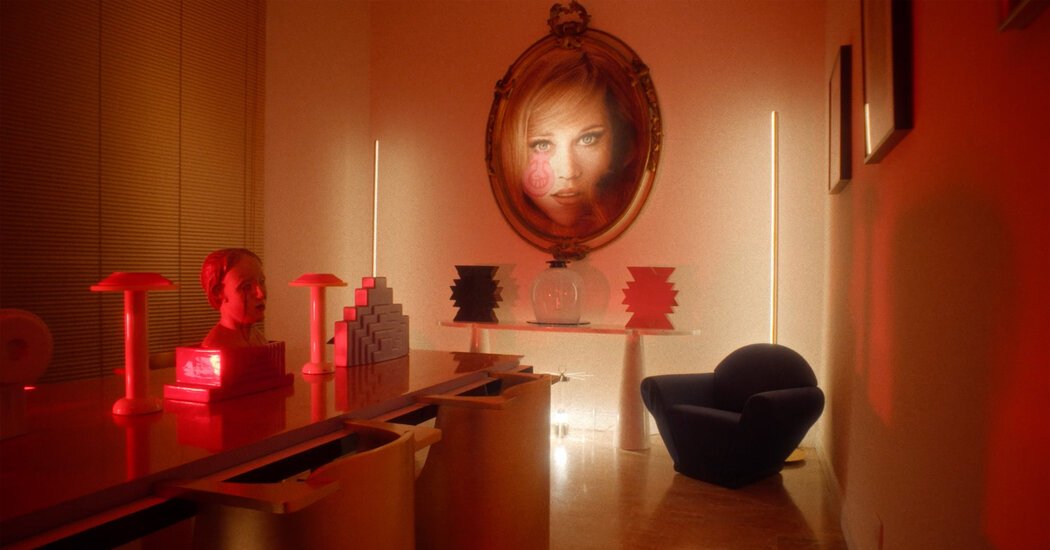When the Italian artist Francesco Vezzoli was in his early 20s, he lived in the back room of an office in an 18th-century building in the middle of Milan. It belonged to the lighting brand Flos, and Piero Gandini, then the company’s owner, “was a patron of mine in the 15th-century sense, in that he was literally paying for my bed,” the artist says. Nearly 20 years later, when he came across an apartment for rent in the same building, he immediately took it. “It was the greatest gift. I already knew how the space worked,” says Vezzoli, now 53. “The fewer things you have to worry about, the more you can dedicate to your [art].” He now also uses a unit on the floor below as his studio and gallery. “If the same slice became free on another floor,” he says. “I’d get it just for the sake of it.”
Vezzoli’s apartment and studio are his “playhouse,” as he puts it — populated by his own cast of artistic muses and celebrity idols. His 1,600-square-foot home has glossy, amber-toned parquet floors and is dimly lit. And the few lamps there look like biomorphic sculptures; among them is FontanaArte’s egg-shaped Uovo model from 1972, which sits atop a 1939 Meret Oppenheim table with spindly, bird-shaped legs. In the living room, cream-colored venetian blinds block the persistent glow from nearby billboards. “I know what a great view is, and I know I can’t afford it,” Vezzoli says, “but I can build my own little universe inside my place.”
Since the late 1990s, Vezzoli has been known for making films, embroideries and performance works that deftly satirize pop culture and art history. In his 2009 faux advertisement “Greed, a New Fragrance by Francesco Vezzoli,” he cast the actresses Natalie Portman and Michelle Williams as two ingénues who brawl over a perfume bottle. For his 2024 exhibition at Venice’s Museo Correr, he reimagined Classical paintings with embroidered details and renderings of Hollywood actors: His version of Botticelli’s “Birth of Venus,” for example, stars a strutting Richard Gere.
In Vezzoli’s home, a surprising range of cultural references and figures similarly collide. He calls his living room the “Ladies’ Room” because the walls are adorned with several archival images of formidable women, including Barbara Bush, Betty Ford and his own mother, all embellished with Vezzoli’s signature needlework tears. His life-size bronze statue of Sofia Loren, cast in 2011 and modeled after the Metaphysical painter Giorgio de Chirico’s robed muses, presides over the center of the room. In the adjoining dining area, surrounding a round, black lacquered table and dramatically high-backed wooden chairs by the Scottish Art Nouveau architect Charles Rennie Mackintosh are collages from Vezzoli’s “Olga Forever” series, featuring Pablo Picasso’s first wife, the Russian ballet dancer Olga Khokhlova, weeping tears that morph into Cubist figures. “I would hate for people to say this is an expensive apartment,” he says. “I would love for people to say it’s special because Francesco has created his own weird narrative.”
In addition to Vezzoli’s own art, both his apartment and studio are full of vintage Memphis Group pieces; he’s been infatuated with the design collective’s furniture and iconography since his early teens. “I was very precocious,” he says. “I was a Fiorucci kid, a Studio 54 kid, a Memphis kid: all of these things I [was too young to experience] but was desperate to grasp.” At 14, he competed on an Italian quiz show — he ended up winning the episode — and wore a Memphis tie for the occasion. After graduating from university in the mid-90s, he moved to Milan, where he was introduced to Memphis’s founder, Ettore Sottsass, at a dinner party. The designer soon became a mentor, and Vezzoli recently curated an exhibition on Sottsass and one of his most prolific collectors, the fashion designer Karl Lagerfeld, at the Almine Rech gallery in Monte Carlo.
Among Vezzoli’s Memphis acquisitions are ceramic Yantra vases by Sottsass, inspired by Hindu diagrams; a blocky wood-and-laminate Palm Spring table; and a V-shaped club chair. There’s also a 1970 Studio 65 sofa modeled after the actress Mae West’s lips and a 1990 Masanori Umeda armchair that looks like a blooming flower. Vezzoli’s most surprising finds, however, are his most understated. Over the past five years, he’s accumulated roughly 200 vases by the Italian designer and sculptor Giovanni Gariboldi, who began working for the porcelain company Richard Ginori in the 1930s under the mentorship of the brand’s artistic director at the time, the renowned architect Gio Ponti. In Italy, until the second half of the 20th century, “the bourgeoisie would give these kinds of vases as wedding gifts,” he says. “I like the fact that few people know Gariboldi’s work, because I’m likely the biggest collector.” Vezzoli has color-blocked the vases on shelves throughout his space: shades of teal in the living room; red in the studio’s hallway; and white in the bedroom. He’s as much a collector as he is a director, each carefully sourced piece furthering the plot of his own surreal story.






